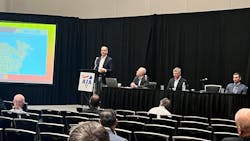Two fleets weigh in on their EV transition progress
AUSTIN, Texas—With emissions mandates mounting, electric trucks aren't going anywhere, but fleets are struggling to find exactly where to start decarbonizing. Representatives from motor carrier Bison Transport and electric truck company WattEV met at an American Trucking Associations Management Conference & Exhibition panel to discuss solutions and hurdles to fleet electrification, including challenges such as cost, charging infrastructure, and maintenance.
Economics of electric trucks
Fleets considering EV adoption must take several factors into consideration. One important factor is the economic impact EV adoption will have on the fleet.
Both panelists—Mike Gomes, vice president of maintenance at Bison Transport (No. 68 on the FleetOwner 500: For-Hire list), and Salim Youssefzadeh, co-founder and CEO of WattEV—agreed that comparing the total cost of ownership between diesel and electric trucks is difficult due to the variety of factors at play.
See also: EV transition: Fleets 'very worried' about coming decade
Youssefzadeh shared that WattEV has only ever employed electric trucks in its fleet, so he can’t compare operational costs with diesel-powered vehicles in his own fleet. However, he said this gives WattEV more perspective on how to operate an electric truck as efficiently as possible.
“With us, it comes down to how do we make it more economical for the owner-operators, and that comes down to the total cost of ownership, getting that price per mile as low as possible, as close as possible to diesel,” Youssefzadeh said.
From Gomes’ perspective, he adds the cost of the vehicle plus the cost of the charging infrastructure to support the vehicle into his calculations of TOC comparisons. But he also admitted the company has a long way to go in its EV endeavor. “There are so many unknowns,” Gomes said. “The purchase of the vehicle is clear … but then the response is the afterlife of the vehicle."
See also: Truck charging in the 'real world'
Furthermore, with the costs required to integrate EVs into the fleet, Gomes said it’s important to understand if his shipping customers are willing to absorb some of the costs.
Shortly after Gomes mentioned the electric vehicle's afterlife, the discussion moved to residual value. Youssefzadeh said that once an EV runs several hundred miles—600,000 miles was the number he used—its battery will begin to degrade. But that shouldn’t mean the truck has no more value. Instead, that truck can be sold and used in another application that doesn’t require the maximum range, such as drayage, as he mentioned, which might have a route of only 60 miles per day.
EV maintenance—Complicated or cost-saving?
One aspect of running a fleet that impacts operations and costs is vehicle maintenance. In terms of the total cost of maintenance over the life of the vehicle, Youssefzadeh said WattEV sees little cost in maintaining its EVs and knows that long term, the cost of EV maintenance will be significantly less than the cost to maintain a diesel truck.
Gomes agreed, adding that fewer moving parts and no need for an aftertreatment system help fleets from an operational perspective, as EVs will experience fewer roadside breakdowns. On the technician side, Gomes said basic mechanical systems remain the same in an EV as in a diesel-powered vehicle, and as a result, he’s seeing technician training “ramp up.”
See also: FleeTec diesel technician academy looks to EV future
Both Youssefzadeh and Gomes were asked whether they preferred electric vehicles produced by larger, well-established OEMs over those produced by innovative startups making waves in the industry.
“I love the innovation that’s in the space,” Gomes said. However, he admitted, “We do look for partnering with larger OEMs because it is a scale business. We have to be able to understand when there are hiccups and faults with the vehicles and the ability to support that, and that’s important to us for the continuity of our business and the continuity of the investment that we do make.”
Youssefzadeh said that WattEV has, for the most part, been OEM agnostic, but thinking about the long term, “we want to work with a manufacturer that has the products in place and has the factories so that we’ll be able to scale.”
About the Author
Jade Brasher
Senior Editor Jade Brasher has covered vocational trucking and fleets since 2018. A graduate of The University of Alabama with a degree in journalism, Jade enjoys telling stories about the people behind the wheel and the intricate processes of the ever-evolving trucking industry.

